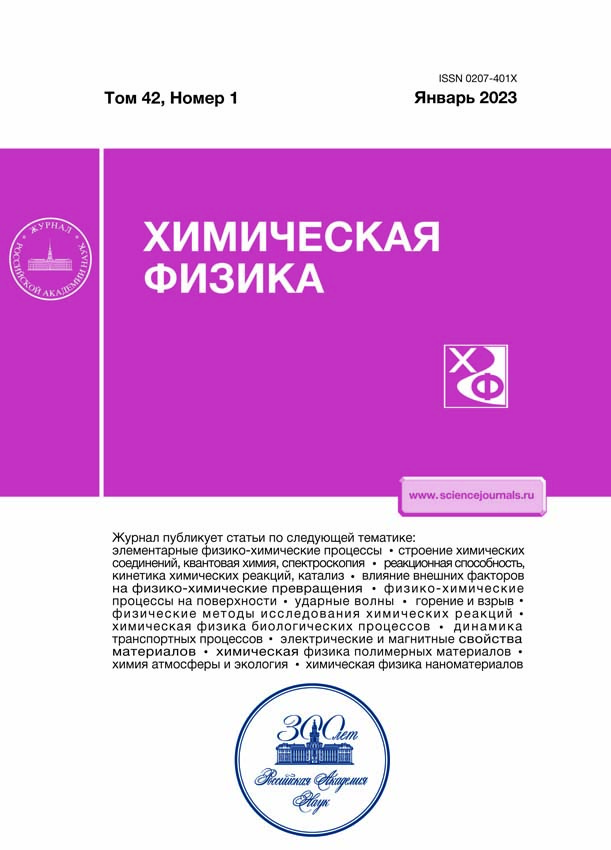Electrically Enhanced Catalytic Activity of Gold Nanocoatings in Carbon Monoxide Oxidation
- Autores: Grishin M.V.1, Gatin A.K.1, Slutskii V.G.1, Fedotov A.S.2, Kharitonov V.A.1, Shub B.R.1
-
Afiliações:
- Semenov Institute of Chemical Physics, Russian Academy of Sciences, Moscow, Russia
- Topchiev Institute of Petrochemical Synthesis, Russian Academy of Sciences, Moscow, Russia
- Edição: Volume 42, Nº 1 (2023)
- Páginas: 3-9
- Seção: Kinetics and mechanism of chemical reactions, catalysis
- URL: https://rjeid.com/0207-401X/article/view/674907
- DOI: https://doi.org/10.31857/S0207401X23010053
- EDN: https://elibrary.ru/MOXHLV
- ID: 674907
Citar
Texto integral
Resumo
Measurements are reported of the increase in catalytic CO oxidation rate on gold nanocoatings obtained by applying a positive or negative electrical voltage of variable magnitude to a coating. In experiments on an initial mixture of 1.8% СО + 10.2% О2 + Ar and a coating with a starting particle size of 0.2 to 3 nm, conducted at 430°C and atmospheric pressure, the extent of the CO oxidation rate enhancement caused by a stepwise increase in the applied positive voltage initially amounts to 28% at +10 V and then declines to 20% at +30 V. Applying a negative voltage has a weaker effect: after an initial increase by 12% at –10 V, the extent of the enhancement of the CO oxidation rate declines to 7% at –30 V. Quantum chemical calculations are performed to determine the heats of association for CO and O2 with the simplest electrically neutral or electrically charged Au3 cluster, as well as the heats of the reaction for Au3CO + O → Au3CO2 and Au3CO2 → Au3 + CO2 involving differently charged Au3 complexes. Based on the calculated results, an explanation is proposed for the increased catalytic CO oxidation rate on electrically charged gold nanocoatings.
Sobre autores
M. Grishin
Semenov Institute of Chemical Physics, Russian Academy of Sciences, Moscow, Russia
Email: jcp@chph.ras.ru
Россия, Москва
A. Gatin
Semenov Institute of Chemical Physics, Russian Academy of Sciences, Moscow, Russia
Email: jcp@chph.ras.ru
Россия, Москва
V. Slutskii
Semenov Institute of Chemical Physics, Russian Academy of Sciences, Moscow, Russia
Email: jcp@chph.ras.ru
Россия, Москва
A. Fedotov
Topchiev Institute of Petrochemical Synthesis, Russian Academy of Sciences, Moscow, Russia
Email: jcp@chph.ras.ru
Россия, Москва
V. Kharitonov
Semenov Institute of Chemical Physics, Russian Academy of Sciences, Moscow, Russia
Email: jcp@chph.ras.ru
Россия, Москва
B. Shub
Semenov Institute of Chemical Physics, Russian Academy of Sciences, Moscow, Russia
Autor responsável pela correspondência
Email: jcp@chph.ras.ru
Россия, Москва
Bibliografia
- Csere Csaba // Car and Driver. 1988. V. 33. № 7. P. 63.
- Kaspar J., Fornasiero P., Graziani M. // Catal. Today. 1999. V. 50. № 2. P. 285.
- Brandt E., Wang Y., Grizzle J. // IEEE Trans. Control Syst. Technol. 2000. V. 8. № 5. P. 767.
- Алексахин А.В., Кириченко А.С. // Экономика в промышленности. 2013. № 4. С. 3.
- Guzman J., Gates B.C. // J. Amer. Chem. Soc. 2004. V. 126. № 2. P. 2672.
- Ануфриенко В.Ф., Мороз Б.Л., Ларина Т.В. и др. // ДАН. 2007. Т. 413. № 4. С. 493.
- Nikolaev S.A., Golubina E.V., Krotova L.N. et al. // Appl. Catal., B. 2015. V. 168. P. 303.
- Takei T., Akira T., Nakamura J. et al. // Adv. Catal. 2012. V. 55. P. 1.
- Бухтияров В.И., Слинько М.Г. // Успехи химии. 2001. Т. 70. № 2. С. 167.
- Roldan Cuenya B. // Thin Solid Films. 2010. V. 518. № 12. P. 3127.
- Гришин М.В., Гатин А.К., Дохликова Н.В. и др. // Кинетика и катализ. 2015. Т. 56. № 4. С. 539.
- Эллерт О.Г., Цодиков М.В., Николаев С.А., Новоторцев В.М. // Успехи химии. 2014. Т. 83. № 8. С. 718.
- Николаев С.А., Смирнов В.В., Васильков А.Ю., Подшибихин В.Л. // Кинетика и катализ. 2010. Т. 51. № 3. С. 396.
- Simakova I.L., Solkina Yu.S., Moroz B.L. et al. // Appl. Catal., A. 2010. V. 385. № 1–2. P. 136.
- Roldan Cuenya B., Behafarid F. // Surf. Sci. Rep. 2015. V. 70. № 2. P. 135.
- Ланин С.Н., Пичугина Д.А., Шестаков А.Ф. и др. // ЖФХ. 2010. Т. 84. № 12. С. 2330.
- Гришин М.В., Гатин А.К., Слуцкий В.Г., Харитонов В.А., Шуб Б.Р. // Хим. физика. 2015. Т. 34. № 7. С. 3.
- Гришин М.В., Гатин А.К., Слуцкий В.Г. и др. // Хим. физика. 2020. Т. 39. № 3. С. 29.
- Гришин М.В., Гатин А.К., Слуцкий В.Г. и др. // Хим. физика. 2020. Т. 39. № 5. С. 84.
- Гришин М.В., Гатин А.К., Слуцкий В.Г. и др. // Хим. физика. 2021. Т. 40. № 6. С. 10.
- Гришин М.В., Гатин А.К., Слуцкий В.Г. и др. // Хим. физика. 2021. Т. 40. № 9. С. 3.
- Гришин М.В., Гатин А.К., Слуцкий В.Г. и др. // Хим. физика. 2022. Т. 41. № 6. С. 3.
- Schubert M., Hakenberg S., Veen A. et al. // J. Catal. 2001. V. 122. P. 9523.
- Sankar M., He Q., Engel K. et al. // Chem. Rev. 2020. V. 120. № 8. P. 3890.
- Herzing A., Kiely C., Carley A., Landon P., Hutchings G. // Science. 2008. V. 321. P. 1331.
- Ozaki T. // Phys. Rev. B. 2003. V. 67. P. 155 108.
- Ozaki T., Kino H. // Ibid. 2004. V. 69. P. 195 113.
Arquivos suplementares













